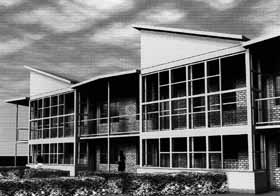
| ||
 | ||
 GRAPHIC COURTESY OF PEARL PODDUBIUK HOGAN ARCHITECTS |
EcoResidence: Design for better living
|
DANIEL McCABE | Home is where the waste water treatment facility is.
Or at least that will be the case for some 90 students at McGill's Macdonald Campus come September. They will be the first occupants of McGill's EcoResidence -- a student residence unlike any other in the country. As they go about cramming for exams and participating in all-night bull sessions, they'll also be at the heart of a unique attempt at making daily living as environmentally friendly as humanly possible. The idea originated last year with Alexandra Zumfelde, an environmental biology student at Macdonald Campus. During a seminar, Zumfelde learned of the existence of ecological living groups -- communities committed to living in harmony with nature -- which first sprang up on university campuses in California in the 1970s. Zumfelde thought it made sense for her campus -- the home of the Faculty of Environmental and Agricultural Sciences, after all -- to have an ecological living group of its own. So she approached Dean Deborah Buszard with a proposal that the faculty donate a small building so that about 20 students could put into practice the principles of an ecological living group on a daily basis. As it happened, Buszard was already mulling over what to do about her campus's Robertson Terrace. The 30-year-old student residence complex was in need of urgent and major repairs. "It was becoming uninhabitable," says the dean. Buszard had a brainstorm -- since the Robertson Terrace required a major overhaul anyway, why not take the opportunity to develop it into something along the lines of Zumfelde's proposal? She approached architecture professor Avi Friedman with the idea and he helped develop the notion of an "EcoResidence." He also introduced Buszard to Daniel Pearl, a recent graduate of the School of Architecture. Pearl, a lecturer in the school and a partner in an architectural firm, is an expert on environmental approaches to architecture. McGill soon hired him to take on the EcoResidence project. "It's exciting to have a client with such an open mind," says Pearl. Once the renovations are completed, the old building will be difficult to recognize, says Buszard. "Robertson Terrace looked rather like a cheap motel," she admits. "The EcoResidence buildings will be much more attractive." The EcoResidence's appearance won't be the only change. There really will be a waste water treatment facility on site. Eschewing chemical methods for treating waste water, the facility will use microbacteria, plants and fish. "We'll be copying the natural methods of a marsh," says Pearl. "Water that's basically raw sewage will be turned into fresh, drinkable water." Rain water will be collected and used for laundry and gardening. Solar energy will be used to keep the buildings warm and to heat the water. Greenhouses will be attached to each of the buildings' apartments to help naturally filter the air. Portions of the old Robertson Terrace that are torn down to make way for the EcoResidence will be recycled and reused. Old windows will be incorporated into the greenhouses. Toxic PVC construction materials will be avoided. Staircases, piping and doors from the Robertson Terrace will find new life as part of the EcoResidence, while other materials such as bricks and concrete, will be crushed to use as fill. "Over the last two years, this kind of approach has really become economically viable," says Pearl. The EcoResidence will be composed of 16 units that will house either four, six or eight students each. A communal garden will be situated at the centre of the EcoResidence as a meeting place as well as a laboratory for horticultural research. Semi-private paths and gardens will link the central courtyard to the individual units. Pearl is currently teaching a course on design at McGill connected to the EcoResidence project. He'll be organizing a one-week Charette -- an intensive architectural planning exercise -- around the EcoResidence with students from both the School of Architecture and Macdonald Campus taking part. "The ideas we turn up might be incorporated into the buildings' final design," says Pearl. The way Buszard sees it, the EcoResidence will be more than just a student residence -- it will be tightly connected to the teaching and research that go on in her faculty and at McGill. Given the unique nature of the structure and its accompanying water treatment facility and communal garden, Buszard envisages teaching and research projects involving the EcoResidence and McGill researchers from architecture, engineering, microbiology, plant biology, agricultural and biosystems engineering, and other areas. "Students are clamouring to put their names down for the EcoResidence," says Buszard. Students who live in the residence will be encouraged to follow the principles of ecological living groups, Buszard adds, "but it will be up to the students in each apartment to decide how they want to live." "This shouldn't just be a place to crash," insists Zumfelde. "The people who sign on should be willing to make a commitment to ecological living." Zumfelde herself plans to make the EcoResidence her home in the autumn. "I'm trying to mooch credits out of this thing for my third-year course project," she confesses. Anyone interested in joining an ecological living group based at Macdonald Campus can contact Alexandra Zumfelde for more information at 481-4389
|
|
| |||||